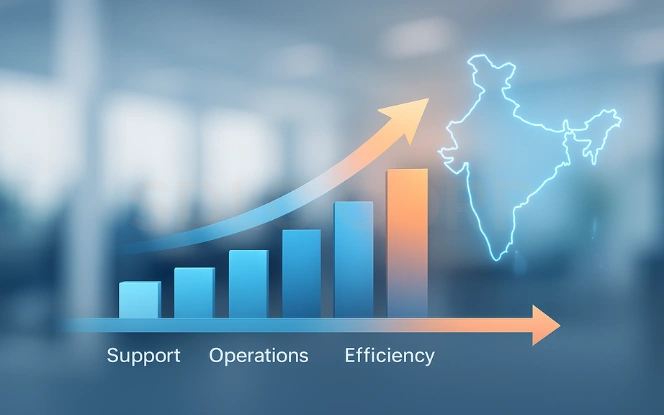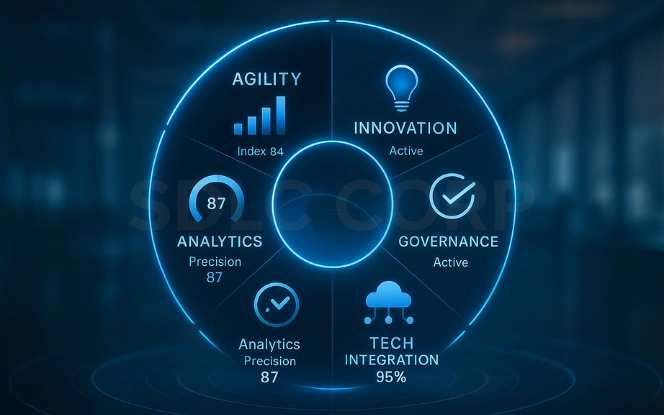Introduction
Global Capability Center India transformation is redefining how global enterprises innovate and scale. India has evolved from being a cost saving outsourcing destination to a strategic hub for technology driven business transformation. These centers are now leading innovation, analytics, and automation for global organizations. Moreover, India’s deep talent pool, robust infrastructure, and digital maturity make it a preferred base for transformation led growth. As a result, GCCs contribute directly to global strategy, product innovation, and value creation. The GCC transformation capabilities India model demonstrates how India’s capabilities extend beyond cost to measurable impact.
Evolution of GCCs in India

India’s GCC journey mirrors how global enterprises have evolved-from cost efficiency to becoming centers of innovation. What began as a support-based model has now transformed into a hub for technology-driven strategic leadership.
Key Stages of Evolution
Stage 1 – Cost Advantage:
In the early 2000s, GCCs were set up mainly to reduce operational costs. They focused on repetitive back-office functions such as data entry, finance processing, and IT support, helping global firms achieve efficiency at scale.
Stage 2 – Process Maturity:
As technology matured, GCCs began adopting automation, analytics, and digital tools. This shift improved accuracy, accelerated processes, and moved centers from simple task execution to value-added service delivery.
Stage 3 – Innovation Leadership:
Modern GCCs now lead digital transformation, AI development, and product engineering initiatives. They are no longer just support units but active innovation partners shaping business strategy and global competitiveness.
Major Enablers of This Evolution
Abundant Skilled Professionals in Emerging Technologies:
India’s vast tech talent pool, skilled in AI, cloud computing, data science, and automation, has fueled this transformation. The availability of domain experts enables GCCs to take on complex, innovation-led roles.
Policy and Infrastructure Support from Government Initiatives:
Government programs such as Digital India and Make in India have strengthened digital infrastructure and encouraged global investment. These policies have created a business-friendly environment for GCC expansion.
Increasing Trust from Global Headquarters in India-Led Delivery Models:
With consistent performance and proven outcomes, global enterprises now view Indian GCCs as strategic centers of excellence. This trust has empowered them to lead innovation and enterprise-wide transformation.
This journey reflects the Global Capability Center India transformation-a shift from execution-based support to innovation-driven leadership.
Strategic Purpose and Business Alignment

Modern GCCs have evolved from operational hubs to strategic partners that directly influence enterprise growth, innovation, and profitability. By integrating technology, business strategy, and execution, they ensure that every initiative supports the broader corporate vision.
Key Elements of Business Alignment
Unified Vision:
GCCs now align their objectives with enterprise-wide priorities such as digital transformation, sustainability, and revenue growth. This shared vision ensures that every initiative contributes to long-term business value.
Cross-Functional Collaboration:
Today’s GCCs work closely with global business teams, enabling real-time collaboration across functions like R&D, marketing, and operations. This approach helps co-develop end-to-end solutions that meet enterprise goals faster.
Customer-Centric Metrics:
Performance is now measured through KPIs focused on customer satisfaction, innovation impact, and business scalability. This ensures that outcomes are not just efficient but also meaningful for clients and end users.
Transparent Governance:
Data-driven governance frameworks empower leaders with actionable insights. This transparency builds accountability, supports better decisions, and maintains alignment between onshore and offshore operations.
Strategic Outcomes
Better Synergy Between Headquarters and India-Based Teams:
Aligned goals and collaborative tools have strengthened trust, allowing both teams to operate as one integrated unit delivering consistent business value.
Faster Innovation Cycles and Improved Agility:
Streamlined communication and agile development enable quicker prototyping, testing, and deployment—reducing time-to-market and accelerating transformation.
Long-Term Operational Excellence and Strategic Continuity:
Through sustainable practices and data-backed strategy, GCCs ensure continuity in operations while driving innovation for future readiness.
India’s GCCs have become global think tanks that not only execute but also design, deliver, and optimize business outcomes.
To explore how enterprises are building future-ready ecosystems, visit High Performance Global Capability Centers in the UAE.
GCC Transformation Capabilities India Framework

The GCC transformation capabilities India model is founded on five connected pillars that drive innovation, efficiency, and long-term scalability. These pillars ensure that organizations achieve consistent value creation while strengthening their transformation journey.
Core Transformation Pillars
Technology Enablement: Adoption of cloud platforms and artificial intelligence has improved agility and automation. This enables GCCs to optimize workflows, reduce manual tasks, and support smarter, faster decision-making.
Process Reinvention:
Modern frameworks built on lean and agile practices allow faster delivery and adaptability. Digital-first methods ensure operations remain responsive to changing business needs and market conditions.
Analytics and Insights:
Advanced data modeling and predictive analytics help enterprises anticipate challenges and opportunities. This capability empowers leaders to make accurate, data-backed decisions across global functions.
Innovation and Product Ownership:
GCCs now design, develop, and manage products end-to-end for global markets. They serve as innovation hubs that experiment with new ideas and transform them into scalable business solutions.
Governance and Compliance:
Robust governance ensures ethical operations and adherence to international regulations. Transparent compliance systems protect enterprises from risk and maintain stakeholder confidence.
Benefits for Enterprises
Higher Productivity through Advanced Digital Tools:
Automation, cloud systems, and AI-driven platforms increase efficiency while reducing operational costs. Teams can focus more on strategy and innovation instead of repetitive processes.
Greater Transparency and Measurable KPIs:
Data-backed performance metrics offer real-time visibility into progress. This helps leadership measure the impact of transformation initiatives with accuracy.
Stronger Cross-Functional Integration Across Global Markets:
Collaboration between global business units creates unified execution. It promotes knowledge sharing, faster problem-solving, and better alignment with enterprise goals.
This framework shows how India’s GCC ecosystem converts digital transformation into measurable business excellence.
To explore advanced performance models, visit High Performance GCCs in the US.
India as a Digital Innovation Hub

India’s position as a India GCC digital innovation hub has been strengthened by its growing ecosystem of AI engineers, product developers, and strategic consultants. The combination of advanced technology, innovative mindset, and cost efficiency has made India a global innovation leader.
Why India stands out:
- Talent Advantage: Millions of digital professionals skilled in emerging tech.
- Collaborative Ecosystem: Startups and academia fuel experimental growth.
- Global Integration: Seamless collaboration across time zones and industries.
- Infrastructure Readiness: Reliable data connectivity and cybersecurity infrastructure.
Enterprise benefits:
- Faster rollout of AI led solutions and cloud platforms.
- Increased global confidence in India based delivery models.
- Continuous innovation pipelines sustaining business relevance.
This innovation driven evolution continues to push enterprises forward. Learn how GCCs accelerate performance through AI-First Global Capability Centers.
The Cost to Value Shift

The GCC India cost to value shift marks a major change in how enterprises measure success. Instead of focusing only on cost efficiency, GCCs now emphasize creating measurable business value through innovation, ownership, and strategic contributions.
Key Dimensions of This Shift
Outcome Driven KPIs:
Performance is now evaluated through outcomes that measure speed, scalability, and quality. These KPIs align with enterprise goals, ensuring that every project directly contributes to business growth.
Ownership Mentality:
Teams within GCCs take full responsibility for delivering results from concept to completion. This accountability builds a strong performance culture and improves collaboration with global business leaders.
IP and Innovation:
Indian GCCs are driving intellectual property creation through patents, proprietary tools, and unique frameworks. Their contributions demonstrate a move from execution to leadership in technology and innovation.
Sustainable Growth:
Cost savings achieved through efficiency are now reinvested in research, development, and digital transformation. This cycle supports continuous innovation and long-term competitiveness.
Impact of the Shift
Forty Percent Reduction in Global Project Delivery Time:
Streamlined processes and automation have shortened delivery cycles, helping enterprises launch products and services faster.
Improved Resilience Through Digital Standardization:
Unified digital systems and standardized practices have strengthened operational resilience and reduced business risks.
Enhanced ROI Through Measurable Innovation Impact:
The focus on innovation-led initiatives has improved overall returns on investment, turning GCCs into high-value contributors rather than cost centers.
This transformation from cost optimization to value creation has positioned India’s GCCs as trusted innovation partners for global enterprises.
To understand the financial aspects of establishing these centers, visit How Much Does It Cost To Set Up A Global Capability Center?.
Technology Stack and Talent Trends

The India GCC tech stack and talent trends show how technology and human expertise together fuel transformation. GCCs are embracing hybrid cloud, AI driven systems, and integrated cybersecurity to enhance reliability and scalability.
Technology stack evolution:
- Cloud Native Systems: Multi cloud setups increase flexibility and data protection.
- AI and Machine Learning: Predictive models improve decision making across operations.
- Data Platforms: Unified analytics frameworks provide real time insights.
- Cybersecurity: Zero trust models safeguard critical assets from global threats.
Talent development advancements:
- Cross Domain Skills: Engineers now blend AI, analytics, and design.
- Reskilling Initiatives: Upskilling ensures talent keeps pace with emerging tools.
- Leadership Development: Local professionals lead global transformation mandates.
- Diversity and Inclusion: Broader hiring improves creativity and collaboration.
These trends highlight how Indian GCCs sustain innovation through advanced infrastructure and human potential. The ecosystem continues to evolve with strategic alignment and global integration. For foundational clarity on GCC roles, explore What Is GCC?.
Organizational Structure and Governance

Organizational agility defines the success of modern GCCs. Their governance models now emphasize empowerment, accountability, and outcome driven decision making.
Key elements of governance:
- Agile Teams: Squads own product strategy and execution end to end.
- Transparent Metrics: Dashboards and KPIs allow quick visibility into progress.
- Automated Compliance: Digital audits reduce risk and ensure adherence.
- Collaborative Leadership: Multi level governance connects global and local teams.
Expanded business value:
- Greater adaptability to market changes.
- Higher innovation throughput and quality assurance.
- Stronger cross functional communication across borders.
The India GCC strategic capability centre evolution reflects a shift from control based management to trust based leadership. This evolution ensures that governance supports both innovation velocity and operational security.
Role of AI and Automation in Transformation

Artificial intelligence and automation stand at the heart of Global Capability Center India transformation, enabling faster decision making and lower operational costs. These technologies empower GCCs to become innovation accelerators rather than cost centers.
AI and automation in practice:
- Process Automation: RPA minimizes manual tasks and error rates.
- Predictive Analytics: Machine learning models forecast demand and risks.
- AI in Product Design: Algorithms personalize user experiences.
- Intelligent Infrastructure: AI optimizes system uptime and network performance.
Deeper transformation outcomes:
- 40 percent faster project turnaround.
- Streamlined workflows across finance, HR, and operations.
- Enhanced employee focus on innovation over routine work.
- Greater customer satisfaction through predictive service models.
By integrating AI driven solutions, Indian GCCs continue to lead digital modernization globally. Automation is not merely efficiency based, it is strategic, fostering intelligence and adaptability across business functions.
Managing Challenges in Transformation

Every GCC transformation capabilities India initiative faces challenges related to people, process, and technology. Yet Indian GCCs are known for overcoming them through structured frameworks and transparent governance.
Common challenges:
- Talent Retention: Competition for digital skills is intense.
- Cultural Integration: Global collaboration demands communication fluency.
- Cybersecurity: Expanding cloud environments increase risk exposure.
- Adoption Barriers: Resistance to change can slow digital projects.
Solutions and preventive measures:
- Continuous learning programs and leadership mentorships.
- Collaboration platforms bridging geography and culture.
- Data protection policies reinforced by AI based monitoring.
- Transparent change management communication from leadership.
Long term benefits:
- Higher retention rates and institutional knowledge.
- Streamlined onboarding for new technologies.
- Consistent alignment between global and local objectives.
These proactive approaches enable GCCs to stay competitive and adaptable. Transformation challenges become stepping stones toward operational maturity and business resilience.
The Strategic Evolution of Indian GCCs

The India GCC strategic capability centre evolution highlights India’s transition from outsourcing to global innovation leadership. Indian GCCs now deliver strategy, technology, and governance solutions across diverse sectors.
Milestones shaping evolution:
- Advanced Ownership: GCCs now manage AI, R&D, and sustainability portfolios.
- Talent Export: Indian leaders oversee multinational transformation programs.
- Geographical Expansion: Tier 2 cities provide cost efficient innovation hubs.
- Integrated Operations: Cross industry collaborations boost efficiency.
Future trajectory:
- Stronger AI and quantum computing adoption.
- Sustainable digital models aligned with ESG goals.
- Strategic mergers that include GCCs as core innovation engines.
- Unified enterprise ecosystems driving global competitiveness.
India’s GCCs now operate as independent value creators, driving measurable transformation outcomes for global enterprises. Their evolution symbolizes the maturity of the digital economy and the continued growth of knowledge led industries.
Conclusion
The Global Capability Center India transformation defines a new era of global business leadership. GCCs in India have evolved into strategic powerhouses that merge technology, governance, and talent to deliver sustainable innovation. The India GCC strategic capability centre evolution demonstrates how these centers are transforming enterprises with AI-driven solutions, digital maturity, and operational excellence. As organizations aim to scale efficiently and innovate continuously, India’s GCC ecosystem offers a proven model for global success.
For expert collaboration and enterprise transformation, contact SDLC Corp today to explore how our GCC expertise can accelerate your growth.
FAQs
What Are The Core Benefits Of Global Capability Centers?
Global Capability Centers improve cost efficiency, enhance scalability, and create innovation driven ecosystems. They allow organizations to centralize operations, develop digital solutions, and maintain strategic control over transformation initiatives.
How Does The Global Capability Center India Transformation Support Business Agility?
The transformation equips enterprises with flexible models, AI enhanced operations, and integrated governance systems. This approach enables faster decision making, reduced cycle times, and consistent alignment with strategic business goals.
What Are The Main GCC Transformation Capabilities In India?
They include technology enablement, automation, analytics, and strategic governance. These capabilities strengthen innovation pipelines and ensure long term sustainability across industries.
Why Is India A Preferred Destination For Global Capability Centers?
India provides a rich pool of digital talent, advanced technology infrastructure, and a supportive business ecosystem. This combination allows companies to innovate faster, operate efficiently, and achieve measurable transformation.
How Does The India GCC Strategic Capability Centre Evolution Impact Global Enterprises?
It transforms GCCs into global powerhouses that handle R&D, AI development, and business innovation. This evolution enhances productivity, reduces costs, and strengthens global competitiveness.





